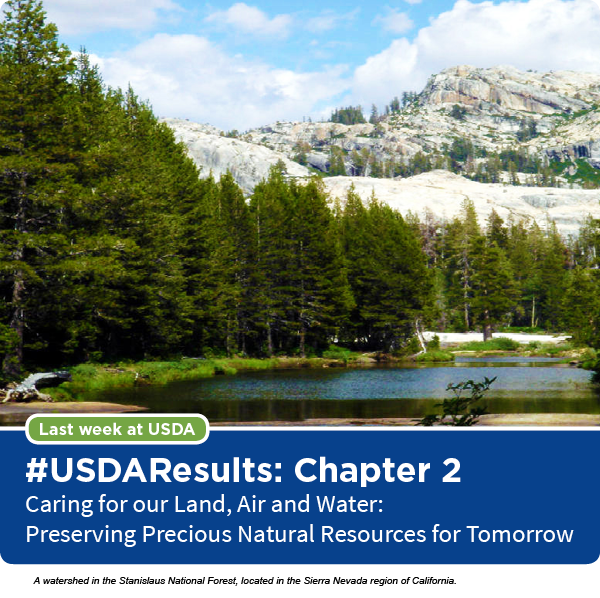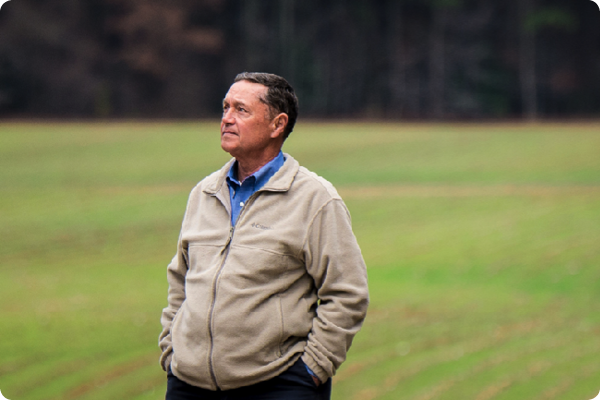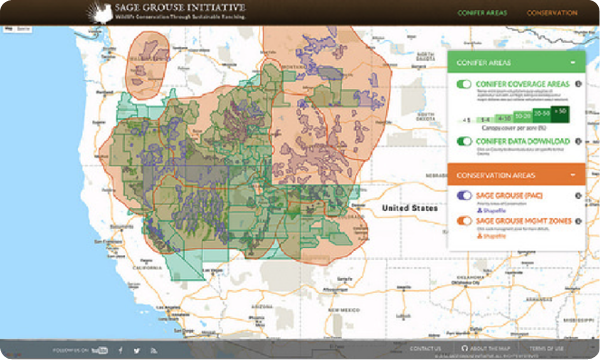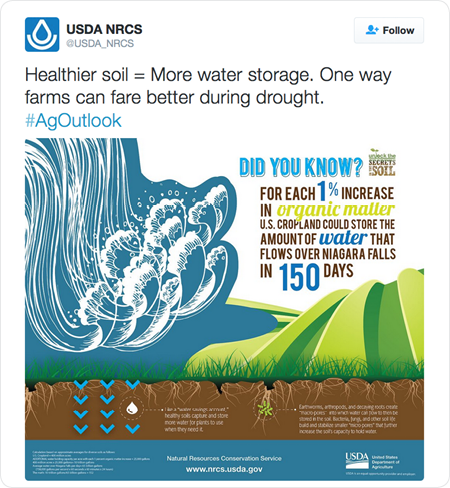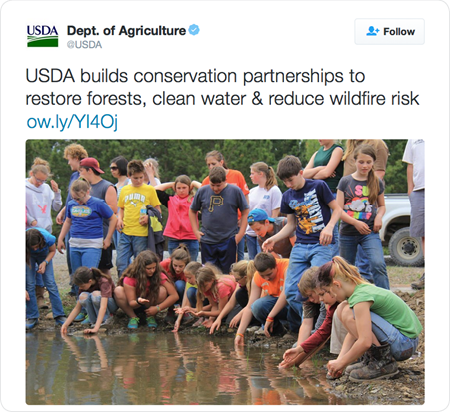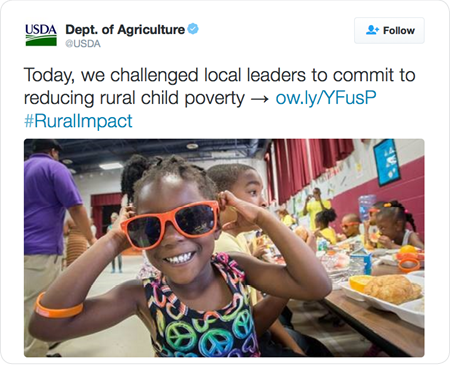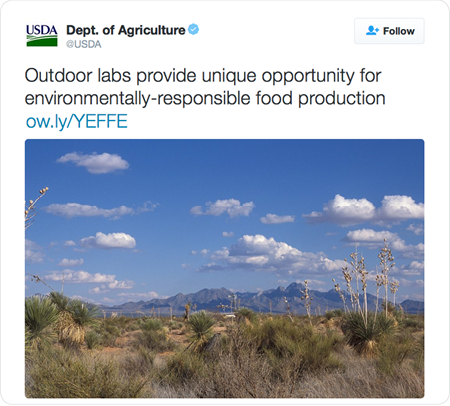Having trouble viewing this email? View it as a Web page.

Listen to Paul Rogers, a peanut farmer from Virginia, and Dell Cotton, Executive Secretary of the Virginia Peanut Growers Association, tell their stories.
The Sage Grouse Initiative SGI Interactive Web Application. The tool graphically layers vital pieces of information to paint a more cohesive picture of connected landscapes, so state and federal agencies and their partners can make more effective and targeted decisions.
Red-backed salamanders and other amphibians are key players in ecosystem health. A team at the University of New Hampshire funded by a grant from USDA is examining how salamanders can influence ecosystem functions, such as decomposition, nutrient cycling, and plant growth in a variety of forest landscapes.
A Peanut Farmer from Virginia on the Trans-Pacific Partnership America’s farmers and ranchers are among the most productive in the world, and they depend on exports. Roughly 20 percent of U.S. farm income comes from agricultural exports, and those exports help to support rural communities across the country. The Tualatin Basin Partners for Clean Water’s membership includes more than a dozen cities, counties, conservation districts, and environmental groups. Lifelong farmer Hezekiah Gibson, and his wife Frances, farm 1,200 acres in Manning, South Carolina. They have been working with USDA’s Natural Resources Conservation Service (NRCS) for years to improve conservation on their farm. In 2014, U.S. Forest Service Chief Tom Tidwell and Natural Resource Conservation Service (NRCS) Chief Jason Weller formed a strategic alliance to establish the Joint Chiefs’ Landscape Restoration Partnership designed to work with local communities to reduce the risk of wildfires, ensure dependable local drinking water and improve wildlife habitat across the country. Each drop of water counts in the Ogallala Aquifer region, which includes nearly all of Nebraska and large sections of Colorado, Kansas, New Mexico, Oklahoma, South Dakota, Texas and Wyoming. A group of forward-thinking farmers in Texas are finding innovative and more efficient ways to irrigate their crops with assistance from USDA’s Natural Resources Conservation Service (NRCS) Ogallala Aquifer Initiative and a Conservation Innovation Grant. A recently published six-year study by researchers at the University of New Hampshire discusses how the loss or reduction of amphibians could affect the ecosystem. Using a grant from USDA’s National Institute of Food and Agriculture (NIFA), the researchers conducted landscape-scale experiments that tested the impacts of forest buffer width vernal pools on population size and structure, body size and condition and population genetics of two amphibian species in the northeastern United States. USDA’s Rural Development investment of over $240 million in its Rural Energy for America Program (REAP) is helping rural communities in North Carolina and across the country develop energy projects that produce clean and renewable power that can keep producers and businesses running. The Sage Grouse Initiative (SGI), led by USDA’s Natural Resources Conservation Service (NRCS), introduces the SGI Interactive Web Application, a tool that will take habitat restoration efforts for sage grouse to new heights — both visually and on the ground. Knowing how a variety of plant and animal species survive and thrive in their natural habitats under a variety of changing environmental conditions may provide some answers to producers to help them meet society’s demands for a sustainable, environmentally conscious food supply system. It is estimated that 50,000 animal and plant species in the United States are non-native, and approximately 5,000 of these species are considered invasive because of the ecological and economic damages they cause. That’s why the National Invasive Species Council and APHIS Wildlife Services (WS) raised awareness about the negative impacts caused by invasive species during National Invasive Species Awareness Week, February 21-27. A partnership between USDA’s National Agroforestry Center and Agri-Food Canada has resulted in the creation of AgBufferBuilder, a geographical information system (GIS) based computer program used for designing vegetation buffers around agricultural fields to prevent soil erosion and fertilizer and pesticide runoff. The AgBufferBuilder program analyzes the lay of a field to determine where and how-much runoff will occur.
How America’s farmers are breathing new life into our nation’s soils.
Virginia Peanut Farmers And TPP Impacts Broadcast Date: Friday, February 26, 2016 Broadcast Date: Thu, February 25, 2016 Broadcast Date: Wed, February 24, 2016 Broadcast Date: Wed, February 24, 2016 Broadcast Date: Wed, February 24, 2016 Broadcast Date: Mon, February 22, 2016 Broadcast Date: Mon, February 22, 2016
Fighting poverty and opiate addiction in rural communities (Marketplace) In America's rural communities, poverty, health and education gaps, and a striking increase in opiate addiction are challenging social services and the budget. News of the increasing numbers of deaths among middle-aged Americans and the high rates of opiate overdoses are in the news, and since 2011, the Obama administration's Rural Poverty Coalition has been tackling the multi-generational issues that come with providing social services to rural America. Agriculture Secretary Tom Vilsack is the only member of the cabinet who’s been there since President Obama took office. He heads a department that oversees a wide swath of government programs, including food safety and food stamps. In the second part of his conversation with Here & Now’s Robin Young, Secretary Vilsack talks about genetically modified food (GMOs) and ethanol. Republican leaders may be pouring cold water on hopes that Congress could take up President Obama’s 12-nation Pacific Rim trade agreement, but Agriculture Secretary Tom Vilsack is still confident that the TPP will pass, according to the Hill’s Vicki Needham. U.S. Agriculture Secretary Tom Vilsack has been been tasked by President Obama with tackling heroin and opioid abuse in rural America. It turns out he has some personal experience with that problem in his family. Secretary Vilsack talks with Here & Now’s Robin Young about the USDA agenda for 2016. On January 7, 2016, the US Department of Health and Human Services (HHS) and the US Department of Agriculture (USDA) released the 2015-2020 Dietary Guidelines for Americans (8th edition), providing science-based recommendations on nutrition for professionals and policymakers to help all people aged 2 years and older and their families consume a healthy, nutritionally adequate diet.
|

